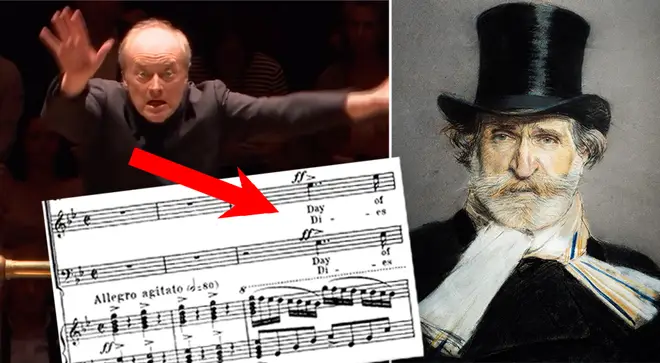What are the lyrics and translation of Verdi’s ‘Dies Irae’ – and which films have I heard it in?
30 October 2020, 15:37

Verdi’s terrifying choral depiction of Judgment Day is up there with the most unsettling musical experiences. From its medieval origins to its meaning, here’s what you need to know.
Four stabs from the orchestra. A sea of swirling strings. Then, a threatening crescendo from the lower voice parts cues in a soaring soprano line announcing, with hellish terror, the Day of Wrath.
So begins the ‘Dies Irae’ section of Verdi’s epic achievement – his Requiem. The work is one of the best-loved choral pieces out here – thrilling to hear, and incredible to sing.
And it’s this intense, fiery section that makes conductors do things like this:
When it comes to spine-chilling music, Verdi’s walloping ‘Dies Irae’ is hard to beat. The words he set have a fascinating history too. It’s an ancient text, now best known from its use in Requiem Masses. Composers from Mozart to Verdi have set these words to music for hundreds of years, each in their own way painting drama and chaos in their writing.
Read more: The 20 scariest pieces of classical music >
But what does it all mean?
To give you a hint, choral composer Bob Chilcott, who conducted the Requiem at the Royal Albert Hall earlier last year, told the Guardian at the time: “It’s about judgment, about the end of the world,” he says. “If you believe what it says, then we’re all stuffed.”
‘Dies Irae’ (literally, Day of Wrath) is a medieval Latin poem, and one of the most famous melodies of the Gregorian Chant. In its original form, it’s a four-note melody describing Judgment Day, the Christian day when humanity will come before God to receive judgment.

Gregorian Chant - "Dies Irae"
What are the lyrics to ‘Dies Irae’?
Dies irae - Dies illa
Solvet saeclum in favilla
Teste David cum Sybilla
Dies irae - Dies illa
Solvet saeclum in favilla
Dies irae - Dies illa
Solvet saeclum in favilla
Teste David cum Sybilla
Dies irae - Dies irae - Dies illa
Solvet saeclum in favilla
Solvet saeclum in favilla
Teste David cum Sybilla - Sybilla
Dies irae - Dies irae - Dies irae
Quantus tremor est futurus
Quando judex est venturus
Cuncta stricte discussurus

Verdi Requiem: 2 Dies Irae
What is the English translation of ‘Dies Irae’?
The day of wrath, that day
Will break up the world into ash
As testified by David and the Sybil
The day of wrath, the day of wrath, that day
Will break up the world into ash
The day of wrath, that day
Will break up the world into ash
As testified by David and the Sybil.
The day of wrath, the day of wrath, that day
Will break up the world into ash
Will break up the world into ash
As testified by David and the Sybil
The day of wrath, the day of wrath, the day of wrath
How much trembling there will be
When the judge comes
And strictly examines all things
What films has ‘Dies Irae’ been used in?
‘Dies Irae’ in its original form – the four-note motif from a 13th-century Gregorian chant – can be found pretty much anywhere on the silver screen, from The Lion King to The Shining.
Vox even did a whole episode on the ancient melody, where they spotted it in The Lord of the Rings, Star Wars – Episode IV A New Hope and It’s a Wonderful Life.
But if you head to Giuseppe Verdi’s IMDb page, you’ll also see his great choral setting cropping up on all sorts of soundtracks – Mad Max, Django Unchained, Black Mirror and The Simpsons, to name a few.
It’s safe to say, the ‘Dies Irae’ has more than stood the test of time.














